Ayodhya, also known as Awadh or Oundh forms a part of the northern state of Uttar Pradesh in India. The city is believed to be on river Ghaghara which is next to Faridabad, a prominent city in Uttar Pradesh. The ancient city of Ayodhya is considered to be one of the seven sacred cities of the Hindus. Ayodhya gets its importance because of its mention in the Hindu epic Mahabharata. This city is considered to be the birthplace of Rama. The town is believed to be ruled by king Dasharatha for over years. During Dasharatha’s reign, the city of Ayodhya was prosperous, fortified, and was densely populated.
During the Buddhist times, i.e. 6th and 7th century Ayodhya came to be the capital of the Kosala kingdom. The fact that Ayodhya was a prominent city during Buddhist time is evident from the fact that there existed several monasteries in the vicinity of the city. In addition to this, there have also been stupas (Shrines) built by emperor Ashoka of the Maurya kingdom. These developments were seen during the 3rd century BC.
Ayodhya later came to be a part of Delhi Sultanate. During this time an important development namely Barbri Masjid (Mosque of Babur) was built by the then Mughal emperor Babur. The mosque was built in the same location where the ancient Hindu temple existed. This specific location was previously known to be Lord Ram’s birthplace. Because of the significance of both Hindu and Muslim religions here, the site became to be a point of contention over time.
On 6th December 1992, the three-story mosque was demolished by a group of people comprising of Hindu nationalists. Following this event, riots took place throughout India. Around 2,000 people were estimated to be dead in these riots. This dispute started to escalate and it reached the Allahabad High Court and further the Supreme Court of India.
To the god we failed: Major Indian newspapers and their coverage on Ram Mandir Bhoomi Puja
The groundbreaking ceremony which was held in Ayodhya on 5th August 2020 was marked by sumptuousness and dignity. A 40-kilogram silver brick along with a sapling was used to lay the foundation. Besides, soil from across the country was also used for the groundbreaking ceremony. The Prime Minister, in his address to the nation, stated that Ayodhya, the birthplace of Ram was now lifted from the centuries-old devastation and renaissance.
The temple town of Ayodhya was decked up. It was in a full swing festive mood. The news channels stationed themselves in the holy town since the previous day itself. The media coverage on the Ayodhya issue seemed more like celebrating PM Modi as about celebrating the Hindu deity Ram. Most of the coverage seemed to be occupied with praises to the PM. While not singing the praises to the PM, the channels tried to provide a virtual tour of the future temple which is supposed to come in Ayodhya.
The event was termed by the PM as “a defining moment” in the nation’s history. Similar headings marked the headlines of major English newspapers in India. Ranging from Indian Express to Times of India, the newspapers glorified the acts of the government and signified the event. Here’s a video from India TV network which aired an animated video showing opposition party like Congress trying to stop Ram Mandir construction and PM Modi despite their efforts laying the foundation stone. This goes on to show how hatred against the opposition parties is easily instigated through our very own news agencies and what is wrong with them.
The Times of India
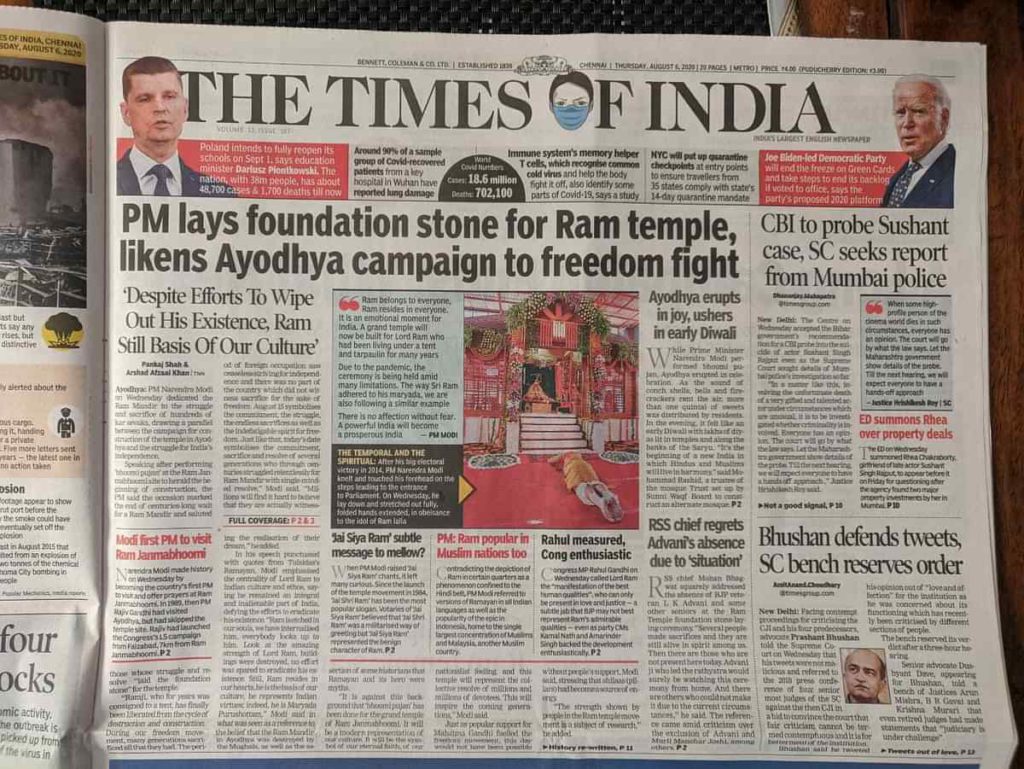
The Times of India is one of the widely circulated English newspapers in India. The front page of the newspaper carried the image of the PM emotionally prostrating to the idol of Ram. It didn’t stop here, there was also a comparison between this and he kneeling before the parliament in 2014. This was reported in a box just next to the picture where PM was seen bowing down to the deity in Ayodhya. This comparison was accompanied by a caption that read “the temporal and the spiritual.”
Further, the newspaper’s lead story mainly consisted of the highlights from the PM address to the nation from Ayodhya. There were even extracts of his speech put in a box next to the main picture on the front page. There was also a comparison made between the freedom struggle and the Ayodhya campaign. Apart from this, the newspaper highlighted the festive mood which decked up the holy city. The regret which was expressed by RSS chief Mohan Bhagwat over the absence of L K Advani from the event was also showcased. The PM usage of the term “Jai Siya Ram” instead of “Jai Shree Ram” and how this term would be popularised shortly. Lastly, the newspaper covered the reaction of the Congress Party on the Ayodhya issue.
The Indian Express
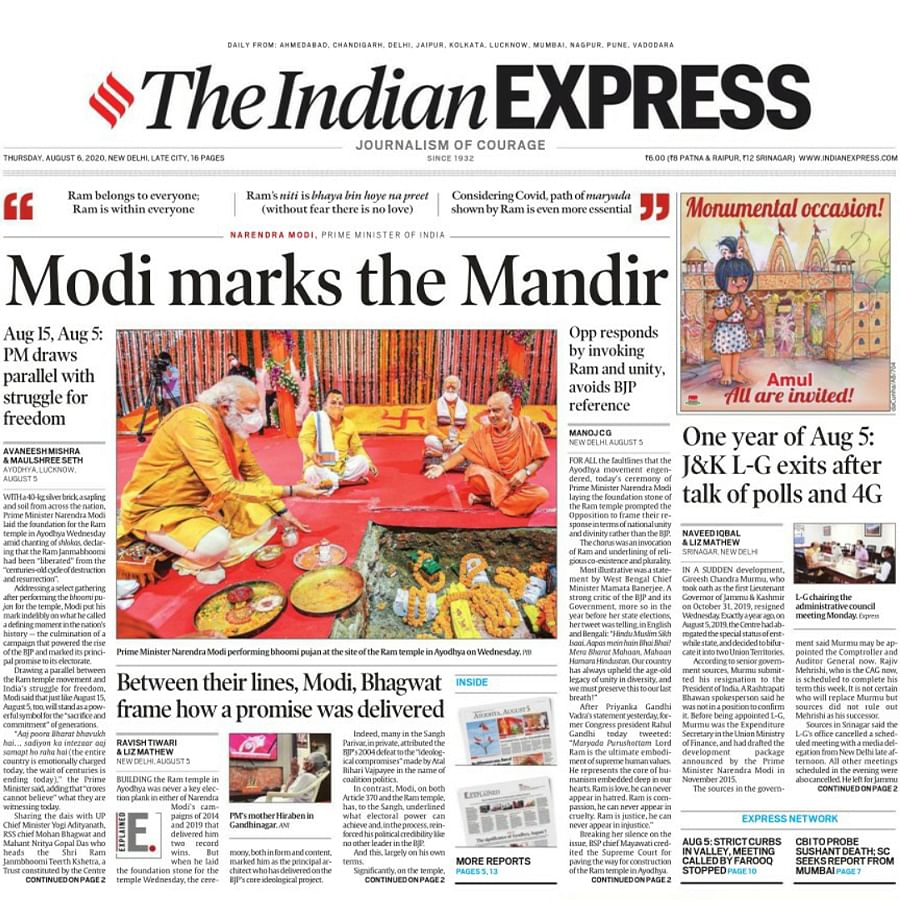
What drags everyone’s attention towards Indian Express’s reporting was that the newspaper headlined its front page with – “Modi marks the Mandir“. Indian Express made a comparison between the foundation of the temple and the country’s freedom struggle. Following the same fashion as Times of India, the front page of the newspaper consisted of PM Modi performing the ceremony. Again there was prime focus put on PM’s address to the nation. The paper spoke about the emotional connection India had with the temple construction. It also spoke about how this event marked an end to the centuries-old wait. All these aspects were a part of the PM’s address to the nation.
Further, the newspaper went on to touch upon the Muslims’ reaction to the temple construction event. The newspaper spoke about how Muslims marked the day in absolute silence. It stated that they had no choice but to accept the Supreme Court verdict on the issue and move on. The newspaper then focused on the response of the opposition party to the ceremony. Lastly, the newspaper spoke about the fulfillment of the Right-wing ideology which was longing from the past so many years. It praised the men who delivered it by working towards it for decades. This address included the PM and the RSS chief Mohan Bhagwat.
Hindustan Times
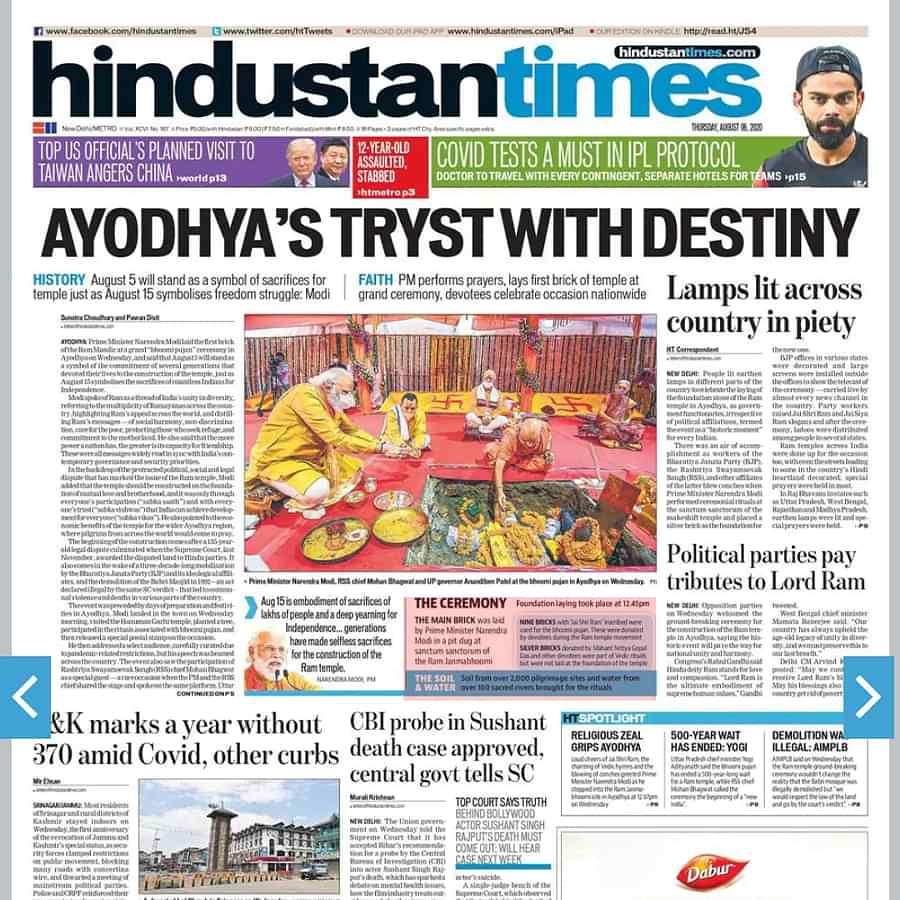
With Hindustan Times’ headlines being “Ayodhya’s tryst with destiny ” the newspaper went on to describe the age-old history of the temple. This included the decades-old land dispute to the Supreme Court judgment rolled out in November last year. The newspaper also spoke about the demolition of Babri Masjid and how it was termed illegal by the Supreme Court. It also added that the temple should be constructed on mutual brotherhood and affection as termed by the PM. It also spoke about the ideologies of the Bharatiya Janata Party which are affiliated to Hindutva. And how the same was to be fulfilled.
In the end, the newspaper included the reaction of the opposition party and various politicians. This included the reactions of Samajwadi Party leader Akhilesh Yadav. Bahujan Samajwadi Party leader Mayawati. Even the statement released by All India Muslim Personal Law Board secretary was included. The statement read- “The quietness of the Muslim Body was because they respected the Rule of Law and agreed with the Supreme Court judgment”.
The Telegraph
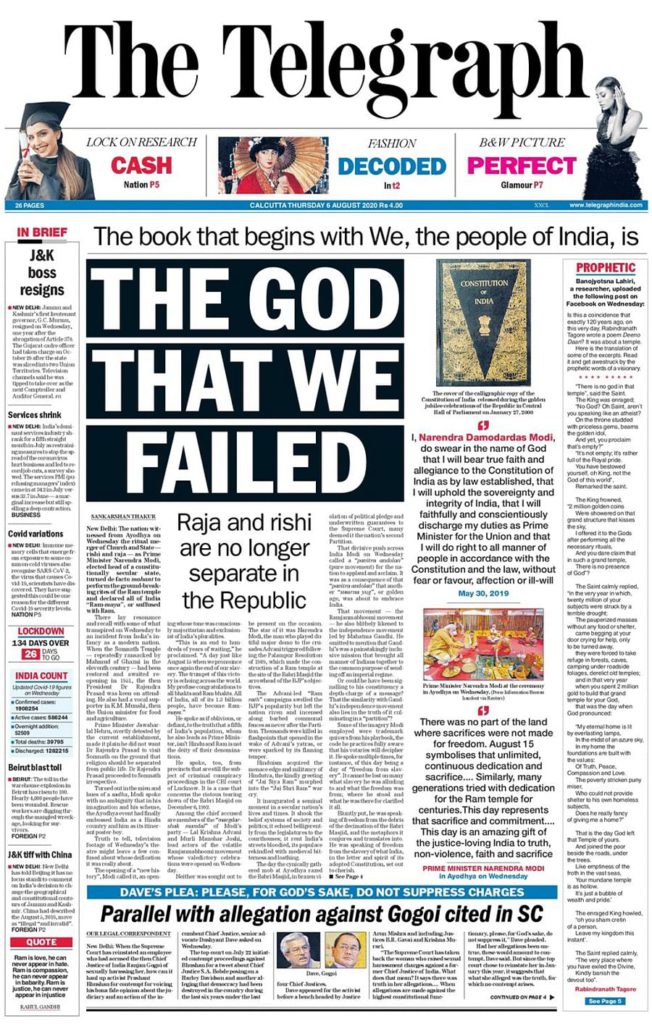
Unlike all the other newspapers, Telegraph, the West Bengal based national daily emphasized its tough call against the existing government. The newspapers’ headline read “The god we have failed“. The Telegraph went on to report on who the PM, an elected head of a secular democracy turned into a de facto mahant to attend the groundbreaking ceremony in Ayodhya. The newspaper went on to address how the PM in his speech termed the country as Ram-Maya which means, the whole country is inundated with Ram.
Further, addressing Modi’s speech on comparing Adhoya temple construction to the struggle of independence, the newspaper hit back by speaking about how on contrary to this, Gandhi strived hard to bring all the religions in India together to fight the colonial rule.
Indian Media and how the TV anchors bowed to Lord Ram
The catchy phrase “Mandir Wahi Banega” seemed to be quenched with the groundbreaking ceremony in Ayodhya. The Ram temple trust invited Prime Minister Modi to attend the groundbreaking ceremony in Ayodhya. The PM was asked to take part in the rituals and the temple building ceremony. The TV anchors seemed to be on a bhakti ride and the same was depicted in their news channels. A gist of the same has been discussed below:
Zee News
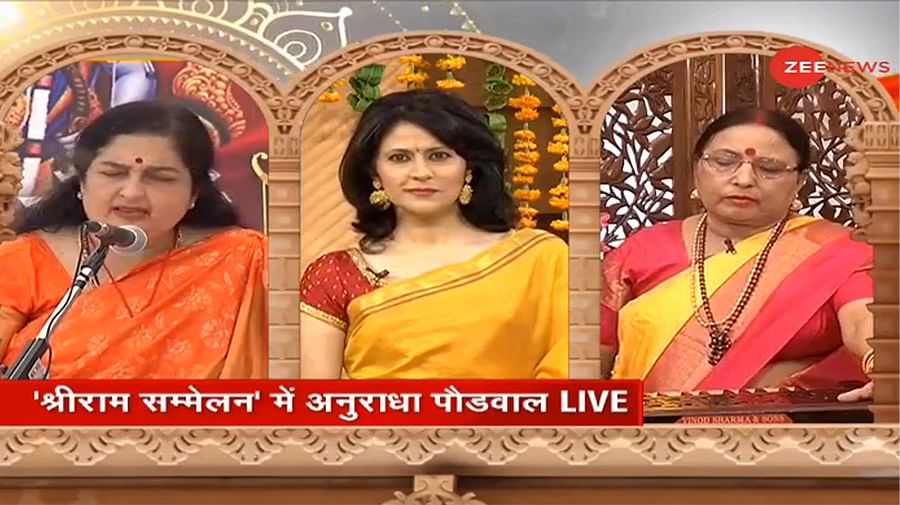
On the day of 5th August 2020, Zee News’ telecast seemed more like that of Astha TV. The channel went a step ahead and hired a singer Anuradha Paudwal to give the news. Anuradha was asked to sing Bhajan praising the lord Ram. While she was singing the anchor seemed all mesmerized in the bhajan and praised lord Ram. This event was also followed by various pictures of the deity Ram being telecasted on the channel. There were also images of politicians put alongside the images of Ram for leisurely fun. Lastly, the anchor spoke about the importance of Ram. The historic event which had come true with the groundbreaking ceremony of the temple.
Aaj Tak
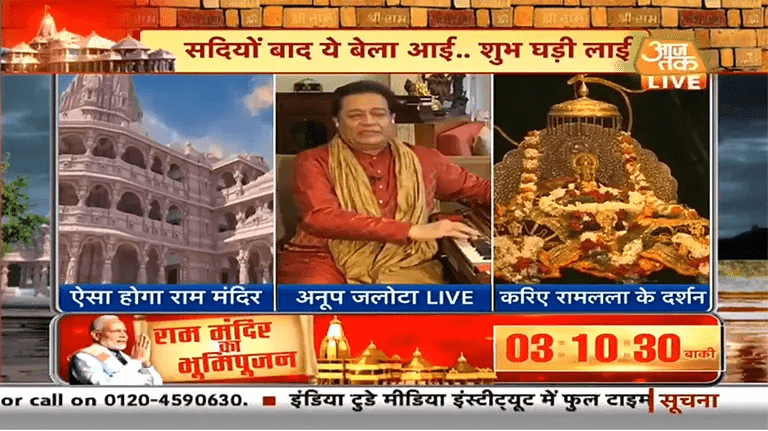
Following a similar fashion as its contemporaries, Aaj Tak also hired a singer to celebrate the historic event. The anchors and the singer seemed to have immersed themselves in the Bhanjan being sung. In addition to all this, there were images of PM Modi put up on their screens. This seemed to have a good effect on the telecasting of the story. The anchor further went on to praise the Prime Minister stating- “Sakshaat Saraswati Pradhan Mantri ke vaani par baithi hogi. Unki manokamna poori ho gayi hai”. Which translates, goddess Saraswati herself must be sitting on the PM’s tongue. To add up to all this the news event showcased 3D images of the temple which is about to come up in the future. Here Modi was seen praying at the temple and the singer used to occasionally pop up on the screens.
Republic TV
The anchors of Republic TV who were reporting live from Ayodhya were noticed without wearing masks. Contrary to this, Lord Hanuman was seen wearing a mask, with Modiji’s image placed on his chest!. During this time there were slight showers seen in Ayodhya. To this, the reporters started interpreting the fact that Lord Indra was blessing this ceremony himself. To this Republic TV quoted – “Jamajam Baarish, Indra Devata ki Saugaat“. Which translates, the rain was a sign of lord Indra’s blessing being showered on the ceremony.
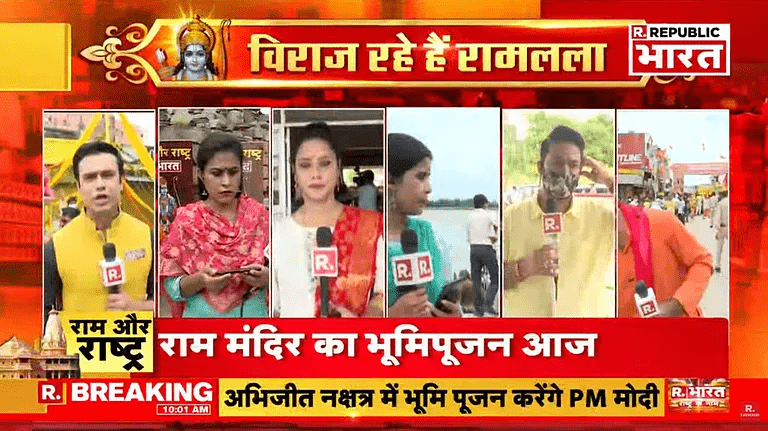
India Today
The anchor Gaurav Sawant, brought all his bhakti in his reporting. He stated, “Ayodhya, primarily known to be the city of Ram was today Modi decked“. This wasn’t very much surprising as Aydhoya happened to have posters of the PM all over. In addition to all this, India Today also telecasted the old footage on the demolition of the Babri Masjid. This event even witnessed the highlight of the PM, as he was also present during the demolition event.
Moving on from this, another anchor Pooja Shaili gave a 3D tour of the temple which is about to come up. The temple tour was in fact, a floor by floor one. The anchor was seen emphasizing the fact multiple times that the PM was wearing a dhoti which is seen as appropriate attire for conducting a puja.
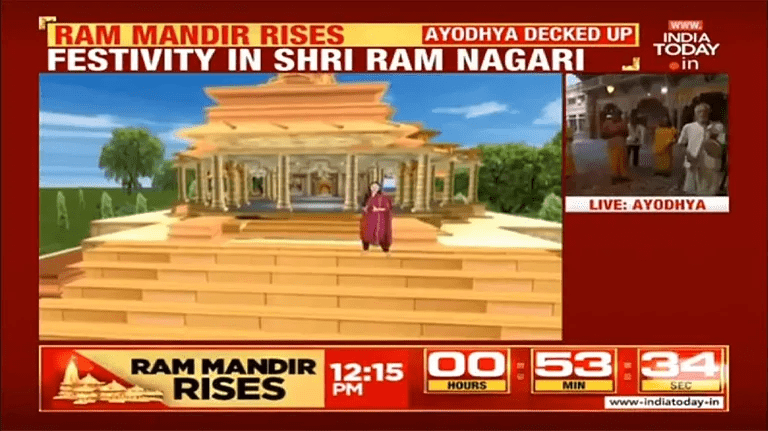
Opposition’s take on Ram Mandir
With PM Modi attending a ‘Hindu’ event and turning it into a grand show, it attracted vast views from opposition leaders. While some parties presented a balanced view, others did not refrain from expressing their disappointment over the event. CM Yogi was also asked about PM Modi attending a ‘communal event’ and why the leaders from the opposition were not invited.
AIMIM along with the party chief Asaduddin Owaisi went ahead to say that Babri Masjid will always be there. Owaisi also showed his disappointment over Pm Modi attending the event. “Pm Modi has violated the oath of office by laying the Ram Mandir foundation stone”, he stated.
He also stated that 5th August is the day of victory for Hinduism, but a defeat for Secularism.
On the other hand, All India Muslim Personal Law Board (AIMPLB) also issued a controversial statement. On Twitter, the board referred to Turkey’s Hagia Sophia to make the point that a mosque remains one “until eternity”.
In a statement, AIMPLB general secretary Maulana Wali Rahmani said: “As the Supreme Court is the highest palladium of justice in our country, we have no option but to accept the judgment. However, we will say that it was an unjust and unfair judgment.”
Owaisi tweets:
#BabriMasjid thi, hai aur rahegi inshallah #BabriZindaHai pic.twitter.com/RIhWyUjcYT
— Asaduddin Owaisi (@asadowaisi) August 5, 2020
आज का दिन हिंदुत्व की जीत का दिन है और secularism की शिकस्त का दिन है। @PMOIndia ने आज अयोध्या में चांदी का पत्थर रख कर वहां हिन्दू राष्ट्र की बुनियाद रखी। – Barrister @asadowaisi #BabriZindaHai #BabriMasjid https://t.co/UQuR8M2Dmh
— AIMIM (@aimim_national) August 5, 2020
AIMPLB Tweet:
بابری مسجد، مسجدتھی اور ہمیشہ مسجد رہے گی۔ غاصبانہ قبضہ سے حقّیت ختم نہیں ہوتی، سپریم کورٹ نے فیصلہ دیا ہے مگر انصاف کو شرمسار کیا ہے!#BabriMasjid #AIMPLB pic.twitter.com/7D2E8nuGuR
— All India Muslim Personal Law Board (@AIMPLB_Official) August 6, 2020
Former Congress Chief Rahul Gandhi instead of using any specific term such as “Bhoomi Pujan” made a subtle political point. He stated, “Lord Ram can never stand for oppression and injustice.”
Rahul Gandhi’s Tweet:
मर्यादा पुरुषोत्तम भगवान राम सर्वोत्तम मानवीय गुणों का स्वरूप हैं। वे हमारे मन की गहराइयों में बसी मानवता की मूल भावना हैं।
राम प्रेम हैं
वे कभी घृणा में प्रकट नहीं हो सकतेराम करुणा हैं
वे कभी क्रूरता में प्रकट नहीं हो सकतेराम न्याय हैं
वे कभी अन्याय में प्रकट नहीं हो सकते।— Rahul Gandhi (@RahulGandhi) August 5, 2020
BSP Leader instead of using the terms “Bhoomi Pujan” or demolition of Babri Masjid gave credit to the Hon’ble Supreme Court for the construction of Ram Mandir. She also stated that Ayodhya is a place of different religions, thus presenting a balanced view.
Mayawati’s Tweet:
1. जैसाकि सर्वविदित है कि अयोध्या विभिन्न धर्मों की पवित्र नगरी व स्थली है। लेकिन दुःख की बात यह है कि यह स्थल राम-मन्दिर व बाबरी-मस्जिद जमीन विवाद को लेकर काफी वर्षों तक विवादों में भी रहा है। 1/3
— Mayawati (@Mayawati) August 5, 2020
2. लेकिन इसका माननीय सुप्रीम कोर्ट ने अन्त किया। साथ ही, इसकी आड़ में राजनीति कर रही पार्टियों पर भी काफी कुछ विराम लगाया। मा. कोर्ट के फैसले के तहत ही आज यहाँ राम-मंदिर निर्माण की नींव रखी जा रही है, जिसका काफी कुछ श्रेय मा. सुप्रीम कोर्ट को ही जाता है। 2/3
— Mayawati (@Mayawati) August 5, 2020
3. जबकि इस मामले में बी.एस.पी का शुरू से ही यह कहना रहा है कि इस प्रकरण को लेकर माननीय सुप्रीम कोर्ट, जो भी फैसला देगा, उसे हमारी पार्टी स्वीकार करेगी। जिसे अब सभी को भी स्वीकार कर लेना चाहिये। बी.एस.पी की यही सलाह है। 3/3
— Mayawati (@Mayawati) August 5, 2020
Trinamool Congress Chief and Chief Minister of West Bengal Mamata Banerjee presented similar views as to Mayawati. She did not mention the words Ram Bhoomi or demolition but instead gave a message of communal harmony.
Mamata Banerjee’s Tweet:
Hindu Muslim Sikh Isaai
Aapas mein hain Bhai Bhai!
Mera Bharat Mahaan,
Mahaan Hamara Hindustan.Our country has always upheld the age-old legacy of unity in diversity, and we must preserve this to our last breath! (1/2)
— Mamata Banerjee (@MamataOfficial) August 5, 2020
Congress leader Shashi Tharoor also expressed his grief over BJP’s celebration. He stated that Lord Ram does not belong to one party and not an exclusive party of BJP. He also mentioned Mahatma Gandhi’s example who always admired Lord Ram and his principles.
Shashi Tharoor’s Tweet:
ShriRam is not the property of BJP. He is the ideal man whose image is deeply etched in the hearts&minds of millions. Gandhiji always sang his hymns& died w/”Hei Ram” on his lips. He talked about a RamRajya where all would live in peace&prosperity. Can’t let His name be hijacked!
— Shashi Tharoor (@ShashiTharoor) August 5, 2020
On being asked about the opposition party not attending the event Uttar Pradesh CM Yogi Adityanth stated the coronavirus pandemic was behind the same. He stated that the omission of the leaders of opposition parties from the Bhoomi Pujan guest list was not due to political reasons. “A lot of people wanted to participate in the ceremony, but only around 200 people could attend it. It’s not just Congress or Samajwadi Party, no political party leader attended the program,” the chief minister said in the interview.
He also went ahead and stated in an interview that being a Hindu, he won’t attend the Mosque event. This statement from CM Yogi indicates that BJP as a party does believe in one religion only. Ram Mandir is a symbol of Unity, Love, and Justice. It should not be used to instigate hatred amongst masses and divide the country into two.
Did 5th August mark the end of secularism in India?
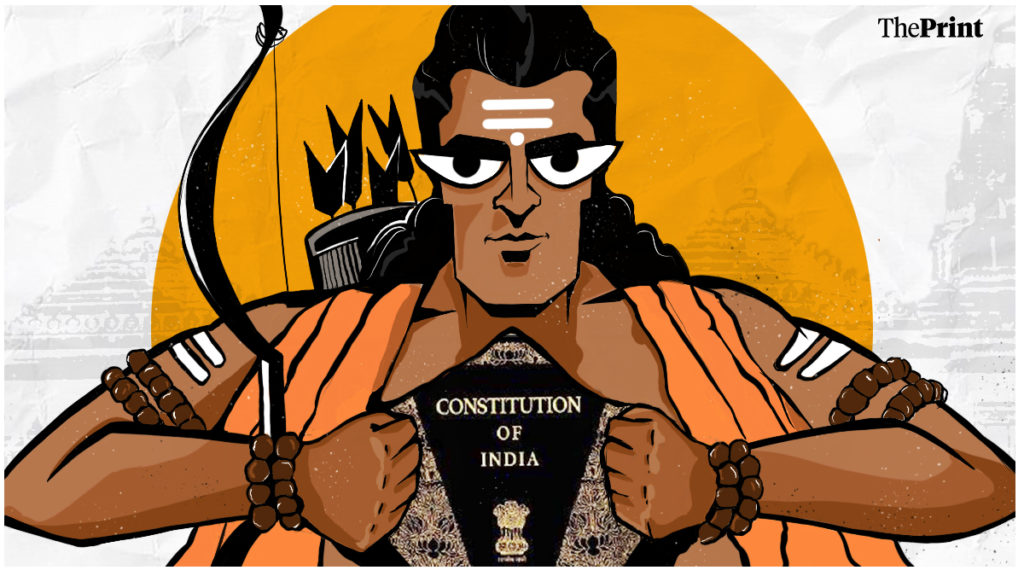
August 5th, 2020 marked the groundbreaking ceremony for Ram temple in Ayodhya. Building a temple or a Mosque or a Church or Gurudwara is not a matter of grief or shame for a secular state. The fact that a politician presided over a religious ceremony in Ayodhya also didn’t bother the secular state of India. It wasn’t something new for a country like India. August 5th, 2020 also marked a year to the scrapping of Article 370. The consequences of this were silencing a Muslim majority state in India overnight. What needs to be paid attention here is the fact the same fate couldn’t be so easily caused to a Hindu majority state in India. The Kashmir tragedy last year rather marks a threat to India’s federalism than to its secularism.
The Bhoomi Puja in Ayodhya which witnessed the presence of PM Modi and Uttar Pradesh chief minister Yogi Adityanath marked the victory of majoritarianism in the country. The ceremony which took place in Ayodhya was not a sacred one. It was more of a political move. The event on a whole can be summarized to be a combination of the dominant powers of the country. These powers include the powerful majority community, the media, the state government, the dominant political party at the center, and lastly the dominant religious authority. All these aspects add up in creating a viable notion of Hindu Rashtra with an attuned fiction of secularism. The only aspect missing from this event was the opposition party. With all these developments being witnessed in the country, the Congress party seemed to have hammered the last nail in the coffin about secularism.

